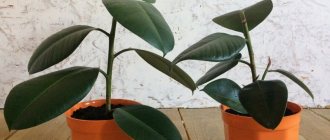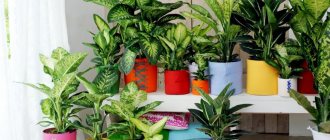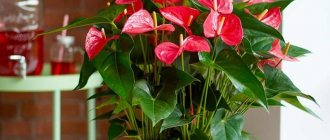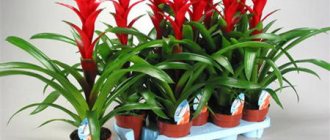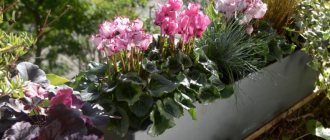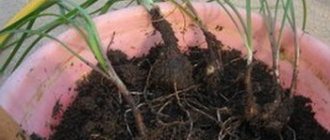Short description
Anthurium magnificum
The plant is loved due to the beauty of the “sail” of the flower. The flower itself is a cone and is unremarkable. But it is enveloped by a blanket sheet of various shapes and colors. After flowering, it turns into an ordinary green leaf.
Characteristic features of anthurium:
- bush height – 40-80 cm (depending on the variety);
- superficial root system and the presence of aerial roots;
- leaves in the shape of a heart, blade or oval, sometimes with cuts;
- usually the leaves are hard; glossy or matte;
- the flower looks like a cone, a spiral, sometimes in the shape of a ball;
- The shape of the bracts is oval, varies among different species;
- the sheet-bedspread has a rich range of colors;
- The aroma of the flower is delicate, but can also be unpleasant.
Indoor anthurium cannot be called unique: easy care and beautiful appearance have made it a common inhabitant of apartments. The plant can bloom all year round. But in its “life routine” cyclicality is also possible: 3 months of flowering and 3 months of rest.
Among gardeners, the plant is called the flamingo flower, and among the people it is called “male happiness.” It is believed that the flower gives a man masculine strength, self-confidence, courage and determination in his actions.
Varieties: description and photo
Andre
The most popular type. Its cover is white, pink or red, and its tail is cream or whitish.
Scherzer
The flamingo flower takes an honorable second place. And they call it that because the shape of the cob is very reminiscent of a flamingo. Although its color can be different - from pink to white-yellow.
Crystal
This type of anthurium is distinguished by velvet leaves, giving it a special charm.
Varieties of anthuriums
All indoor representatives of the family. Aroids originate from five species forms, which provide the opportunity for breeders to experiment with colors and leaf shapes
Let's look at the most common flamingo flowers in indoor culture.
Anthurium Andre or Adrianum (andraeanum)
This variety is the most famous and occurs more often than others.
Anthurium Andre or Adrianum Native to the highlands of Colombia, this flowering tropical inhabitant leads the life of an epiphyte in nature. Anthurium andreanum is a classic version of “male happiness”.
It has glossy red, heart-shaped stipules with yellow spikes rising above them. Leaves of rich green color and lanceolate shape up to 40 cm in length create a beautiful, lush bush.
Based on Andre, copies have been created that differ:
- duration of flowering (from 1 to 12 months);
- palette of colors (there are two-color forms);
- height;
- shades and size of the leaf blade.
A feature of the “tropicana” is its long flowering. Anthurium flowers bloom from October to March or keep their shape all year round. They stand for a long time when cut. This is due to a waxy coating on the surface, which protects against moisture loss and helps maintain freshness for a long time.
Anthurium Scherzer
An unusual flower gives the plant a fabulous, elegant look
Scherzer's Anthurium Anthurium scherzerianum follows Andre in popularity. Originally from the tropics of Guatemala and Costa Rica, it reaches a height of 30-40 cm. Despite this, it is compact and fits perfectly into the interior of a small apartment.
The barrel is shortened. Between the dense, wedge-shaped, elliptical foliage are intricate, red stipules. The leaf-spread is curved, and the cob is folded in the shape of a spiral. The flower is saturated with orange or red tones.
Flowering lasts from February to July, but can be year-round. In hybrid varieties, the size of the bush and the color of the inflorescence varies. For example, anthurium variety Amaretti has white bracts with red spots.
Anthurium Amaretti is interesting with its rolled bract and twisted spadix
Scherzer's anthurium is demanding to care for. Breeding conditions are more complex. It will only grow when there is plenty of heat.
Pink Anthurium or Lindena
Light leaves and pink stipules create a delicate combination
Pink anthurium or Linden Anthurium Lindenianum is not inferior in beauty to Andre and Scherzer. It is not so common in indoor culture. Breeders use it when they need to get a new hybrid.
Has the following features:
- the leaves “sit” on tetrahedral petioles;
- heart-shaped, soft green leaf blade with light veins;
- a pink bedspread is crowned with a white or cream cob;
- the flowers emit a pleasant aroma.
The plant is hardy, so it is widely used in landscape design.
Flowers are cut when the flower veil has fully opened and the inflorescence-cob is covered with pollen. The upper part of the peduncle should be strong and hard. In this case, the flowers remain in the bouquet for a long time. At the bud stage, fragile flower shoots are not cut off.
Anthurium Crystal
Leaves with light veins, golden-emerald hue, do not need additional floral framing
Crystal Anthurium Anthurium Crystallinum does not have particularly beautiful flower stalks. The plant is valued for its decorative foliage.
The plant has:
- large sizes;
- velvety, matte surface of the leaves;
- emerald veins on their surface;
- the ability to change colors depending on age.
In appearance it is similar to the Majestic Anthurium. The “crystal plant” is not capricious, caring for it is not difficult.
It is often used in greenhouse flower beds. Planted around the perimeter, flowers serve as a living fence.
Anthurium Black Queen
The bloody burgundy flower is both frightening and eye-catching.
Anthurium Black Queen Distinguished by its bracts of a dark red hue. As they open, the cherry blossom buds gradually become red and then acquire increasingly darker tones. They are framed by dark green, leathery leaves that do not change their shade.
This species is considered whimsical. The Black Queen is an acquired taste: not everyone likes her mournful look, but you can’t refuse her unusual and exotic attire.
Each variety of flamingo flowers has its own zest, uniqueness, and beauty. By combining several varieties, you can create interesting compositions, playing on the size of the leaves, their color, shape, and flower color. A cloud of subtle aromas of flowering plants creates a special aura.
The genus Anthurium is translated from Greek as "flower" and "tail". In most varieties, the flower-veil actually resembles a tail. It can be narrow, spirally twisted, dark or light, straight or with curved lines.
Anthurium Zizu and Fiorino - differences
Anthurium Fiorino is one of the rare varieties of the crop. Unlike the Zizou variety, its large leaves are located on tall stems. And the cup-shaped bract in the shape of a tulip is painted in a bright purple color. However, as the plant matures, this shade changes to bright pink.
Another difference between anthurium Zizu and Fiorino: the first variety, despite the compactness of the bush, produces large flowers, while the second variety produces miniature ones . There is also a difference in the flowering period. For Fiorino, it lasts about six months, and Zizu, with ideal care, can form buds almost continuously.
Anthurium care
Tropical exotics that came to our apartments from the Amazon River delta require special treatment
Ideally, anthurium will be suitable for the conditions in which it lived in its homeland . But breeders have created unpretentious hybrids that can withstand the atmosphere of modern apartments.
Illumination
On a windowsill with shading
The flamingo flower does not tolerate direct sunlight. They have a detrimental effect on the plant: the leaves turn yellow and burns appear on them. Anuriums will grow in indirect sunlight. Slight shading possible.
Sunburn
Plants are placed on eastern or northwestern windows. On the northern side, flowering will stop, as a 10-hour daylight is required. To make anthurium bloom, winter lighting is necessary.
In winter, the flower is placed on a south window so that it does not suffer from lack of light.
Temperature
Optimum air temperature during plant dormancy +15-20°C
Caring for anthurium includes a thermal regime in which the plant feels as comfortable as possible. Summer temperatures are maintained within +20-+25C, winter temperatures are +15-+20C. A decrease of several degrees from the minimum level causes damage to the plant and its death.
Flowering is possible if the temperature level is close to summer standards. But first you need to hold the “tropicana” at +16-+18C so that flower buds form. After this, you will need to gradually increase the degrees.
Anthuriums do not tolerate sudden temperature changes and cold snaps. You should not leave the flower under an open window in winter or take it out onto the balcony or loggia if frost is expected.
Soil mixture and replanting rules
When replanting, the soil is completely changed. The bush can be divided into several parts, planted in small pots
As the plant grows, it needs to be replanted, which is carried out in the spring every year or every two years. Anthurium replanting is necessary when the root system does not fit into the volume of the pot and the soil is depleted. For these purposes, use a purchased mixture for aroids or orchids.
You can prepare the composition for “male happiness” yourself. For these purposes, universal soil and pieces of conifer bark (1:1) are suitable. A soil containing peat reduces acidity, and crushed pine bark creates additional air space to avoid rot on the roots.
The flamingo flower substrate is rich in components. It includes:
- perlite, which absorbs excess moisture well;
- crushed charcoal;
- river, coarse sand;
- sphagnum moss.
This is the most suitable version of the “earth mixture” for Aroids, but 1-2 components can be excluded from the composition if they are not available. Anthurium is prone to fungal infections, so the soil is disinfected with potassium permanganate before planting.
To prevent residue from water salts from remaining on the leaves, they are wiped with a soft microfiber cloth.
You need soil that meets the following requirements:
- nutritious;
- easy;
- breathable;
- with neutral acidity.
A small plastic pot is required. It is not advisable to plant in clay pots because they only have one drainage hole.
They are planted in a container 2-3 cm larger than the previous one, since the anthurium root system feels “uncomfortable” in large volumes of soil. A small pot will ensure stable growth and a beautiful appearance of the plant, and also stimulate flowering.
Transplanting a plant
Secrets of proper transplantation:
- The bottom of the pot is ¼ filled with a layer of expanded clay. Drainage is necessary, since the flamingo flower does not tolerate stagnant moisture.
- Then the pot is filled 1/3 with soil
- Gently straighten the roots in the pot and distribute the growing mixture evenly
- A universal substrate will help rejuvenate the plant and breathe a second life into it.
Having bought an anthurium and made sure that it is healthy, they transplant the plant to a “permanent place of residence.” To do this, select a pot 2-3 cm larger in diameter and transfer the new indoor plant.
As the old anthurium grows, the lower leaves of the plant die off, and the bush gradually loses its decorative effect. To rejuvenate the old specimen and give it an attractive appearance, the top is cut off and rooted.
Anthurium: replanting after purchase in the video below.
Anthurium transplant after purchase
Anthurium: types and varieties, planting and care at home, propagation, replanting | (Photo & Video)
Watering
A tropical plant needs plenty of moisture.
Anthurium loves watering. Stagnation of moisture is detrimental to the plant, which causes rotting of the roots. The pot should have several holes in the bottom and good drainage. After watering, remaining moisture from the tray must be removed. Usually it is enough to moisten the soil with settled water 2-3 times a week in summer and 1 time a week in winter.
The plant can tolerate short-term drought; it is not able to accumulate moisture. Drooping leaves serve as a distress signal. In this case, the flamingo flower needs to be watered urgently.
Watering is combined with fertilizing. Anthurium is fertilized twice a month in the spring and summer. Usually mineral compositions are used for Aroids. Flowering is stimulated by fertilizers for flowering plants, which contain a full range of essential nutrients. During the dormant period (October-February) the plant is not fed. The exception is diseased specimens, for which the concentration of fertilizer is reduced by 2 times.
“Tropicana” needs a humid climate (60-65%), and the air in the apartment is usually dry. There are three options to get out of the situation:
- Use a humidifier and move the flower away from the radiator
- Place on a tray with damp expanded clay or moss
- Spray the plant periodically and then remove excess droplets of moisture.
Water procedures, simulating rain watering
Transfer
Anthurium needs to be transplanted if:
- It arrived from the store in a shipping pot (the soil in such a substrate is dry, and the pot has large drainage holes, from where the water drains down and stagnates in the pan).
- If the plant has already lived with you for a year or two (this is the period during which the anthurium begins to need fresh soil).
Replanting stimulates more abundant flowering and plant growth.
Choosing a pot
Anthurium loves narrow and small pots. Transplanting into a very spacious home will only affect the appearance of “babies” in large numbers, but not the decorative appearance of the anthurium itself.
Therefore, if the bush has already noticeably outgrown its pot, buy a new pot with a diameter of only 1-2 centimeters larger.
Soil selection
The easiest way to purchase soil for replanting is in the store among ready-made soil mixtures for plants of the aroid and orchid families. This is a light, airy soil that tropical anthurium will like.
Soil preparation
Options for those who want to make their own soil:
- From ready-made soil for begonias with the addition of coconut fiber and coal;
- From peat and humus with the addition of pine needles, coal and brick chips;
- From turf soil, river sand, humus and pieces of coal.
How to transplant an anthurium step by step:
- Pour enough drainage stones into the new pot;
- Fill the pot halfway with soil;
- Carefully transfer the plant from the pot;
- Place the plant in the center of the pot;
- We fill up the soil;
- We water;
- We install it in the chosen place in the house according to the advice on lighting and temperature.
Important:
- Anthurium has very fragile roots that need to be freed from the ground gently and carefully press the soil with your fingers when replanting.
- Anthurium needs aerial roots for life; they should not be trimmed to improve its decorative appearance. Spray them as well as the leaves.
- We do not deepen the root collar when transplanting.
Reproduction
Anthurium can be propagated in different ways without problems at home.
Propagation by seeds
Anthurium seeds
A difficult path for a gardener: at least two seasons will pass from the first shoots to an adult plant. And this is a long wait and painstaking work. But as a result, you can get several dozen small sprouts.
If in nature pollination is carried out by insects, then at home the owner of the “green pet” takes on such work. The spadix consists of bisexual flowers. Flowering begins from the peduncle: first the pistils ripen, and then the stamens.
Armed with a brush, you need to transfer pollen from the stamens to the pistils. Inflorescences are pollinated for 5-8 days to increase the likelihood of obtaining seeds.
When artificially pollinating hybrid forms, the probability of obtaining plants with maternal characteristics is extremely low. It is almost impossible to obtain an original copy.
The secrets of proper and fast propagation are the vegetative option, which gives excellent results.
Dividing the root system
Dividing a large plant makes it possible to obtain several specimens, which quickly grow, forming a full-fledged bush
It is convenient to carry out during transplantation (transfer) of the plant into another pot. The procedure is necessary to rejuvenate the old anthurium and avoid soil depletion.
Root division
The earthen lump is broken, and the overgrown root is divided into several parts, each of which should have a root system and 2-3 leaves. For subsequent lush flowering, divisions of 2-3 specimens are planted in small containers, gradually forming adult specimens.
Places of cuts and any “wounds” (violation of the integrity of the epidermis) are carefully powdered with crushed charcoal or ash so that after transplantation, rotting processes do not begin in the injured areas.
Cuttings
Anthurium - propagation and rooting
Parts of stems are often used for cuttings. Step-by-step instructions for cuttings:
- Cuttings measuring 5-7 cm are carefully cut with a sharp, clean knife at an oblique angle.
- They are planted in soil made from a mixture of sand and peat (1:1) at an angle of 45 degrees.
- The cuttings are covered with a PET bottle with the bottom cut off, creating a microgreenhouse
- Ventilate and moisten the soil daily
- The roots appear in 2-3 weeks.
After rooting, young plants are transplanted into separate containers. Gradually, adult bushes form from them.
Using aerial roots
Through vegetative propagation, several copies of young plants are obtained, which are an exact copy of the mother
Since the flamingo flower is an epiphyte that hangs from tree branches in the jungle, they form aerial roots. This feature is also preserved in indoor plants. Anthurium can be propagated using an aerial root that grows from a section of the stem.
Step by step approach:
- The stem with the aerial root is cut with a sharp, sterilized knife
- The cuttings are planted in the ground and watered
- Rooting occurs within a week
- The sprout is planted in a separate container for further growth.
Diseases and pests
How to care for anthurium if it is sick? Why does the flamingo flower stop blooming? How to save your favorite plant?
A visual inspection can identify the problem:
- The leaf blade turns yellow. Associated with insufficient light and heat. A south window and additional lighting will help solve the problem
- Yellowing of leaf edges. Depends on the dryness of the air. The problem occurs at the beginning of the heating season and is solved by additional spraying. A tray with expanded clay and water is placed under the plant, which creates a humid atmosphere.
- Blackening and falling of the leaf blade. The problem is associated with watering with hard tap water (or cold water), which is dominated by calcium salts. At the same time, the amount of potassium and magnesium is noticeably reduced. Anthurium suffers from a lack of certain salts and begins to shed its leaves
- Drying of leaves and formation of yellow spots on them. Occurs when direct rays of the sun fall on the plant. The leaves get burned and part of the leaf blade dies. Drying of leaves is also associated with pest invasion (aphids, spider mites)
- Black spots on leaves. This is evidence that oxygen access to the roots is limited. Watering should be reduced and the anthurium should be replanted in a fresh (loose and breathable) earthen mixture.
With proper care, such problems will not arise, and anthurium pleases with its external beauty
There are no clear instructions on how to make anthurium bloom. If the care rules are followed, it will reveal its colorful cover without additional manipulation.
Plant toxicity
The juice of most representatives of the family. Aroids are poisonous. It contains calcium oxalate, which causes skin irritation.
When working with a plant - propagation, pruning, replanting - you should wear rubber gloves to protect your skin. In case of burns, first aid measures must be taken. Anthurium is safe for pets: parrots, hamsters, cats, dogs.
How to determine that anthurium is sick?
Sometimes spots appear on the leaves of the flower, the plant withers or its growth rate is impaired. This may be a sign of a flower disease: a man’s happiness may be affected by a bacterial infection, and in this case it is important to know how to cure it.
The appearance of ants and damaged leaves may indicate an aphid infestation. Yellow leaves are caused by spider mites. The appearance of black spots on anthurium leaves is possible due to excessive watering.
Brown foliage indicates bacterial infection or may be caused by other unfavorable factors:
- Excess light - anthurium indoors requires approximately 60% sunlight.
- Excess fertilizer.
- High levels of salts in the soil - salts, like fertilizers, are washed away by abundant watering with purified water. The soil should drain well after this.
- Burn.
- Damaged by microscopic mites - they feed on plant sap, which destroys the green mass of the flower.
- The proliferation of bacteria - most often from diseases caused by bacteria, men's happiness dies. The pathogen spreads in soil, water and on tools through direct contact.
- Spread of nematodes - nematodes are dangerous mainly for young specimens, causing loss of foliage and subsequent death.
To summarize
A noble plant from the Amazon delta will decorate any interior, giving it a special chic and shine. Elegant flowers and leaves will renew the apartment, give warmth and comfort in the winter cold, and add bright colors to the gray atmosphere of everyday life. In combination with other exotic plants, the flamingo flower will fit into a miniature corner of a green tropical paradise in your home.
Anthurium is blooming like crazy, I’m revealing secrets.
Anthurium: types and varieties, planting and care at home, propagation, replanting | (Photo & Video)
5 Total Score
Customer ratings: 5 (1 vote)

